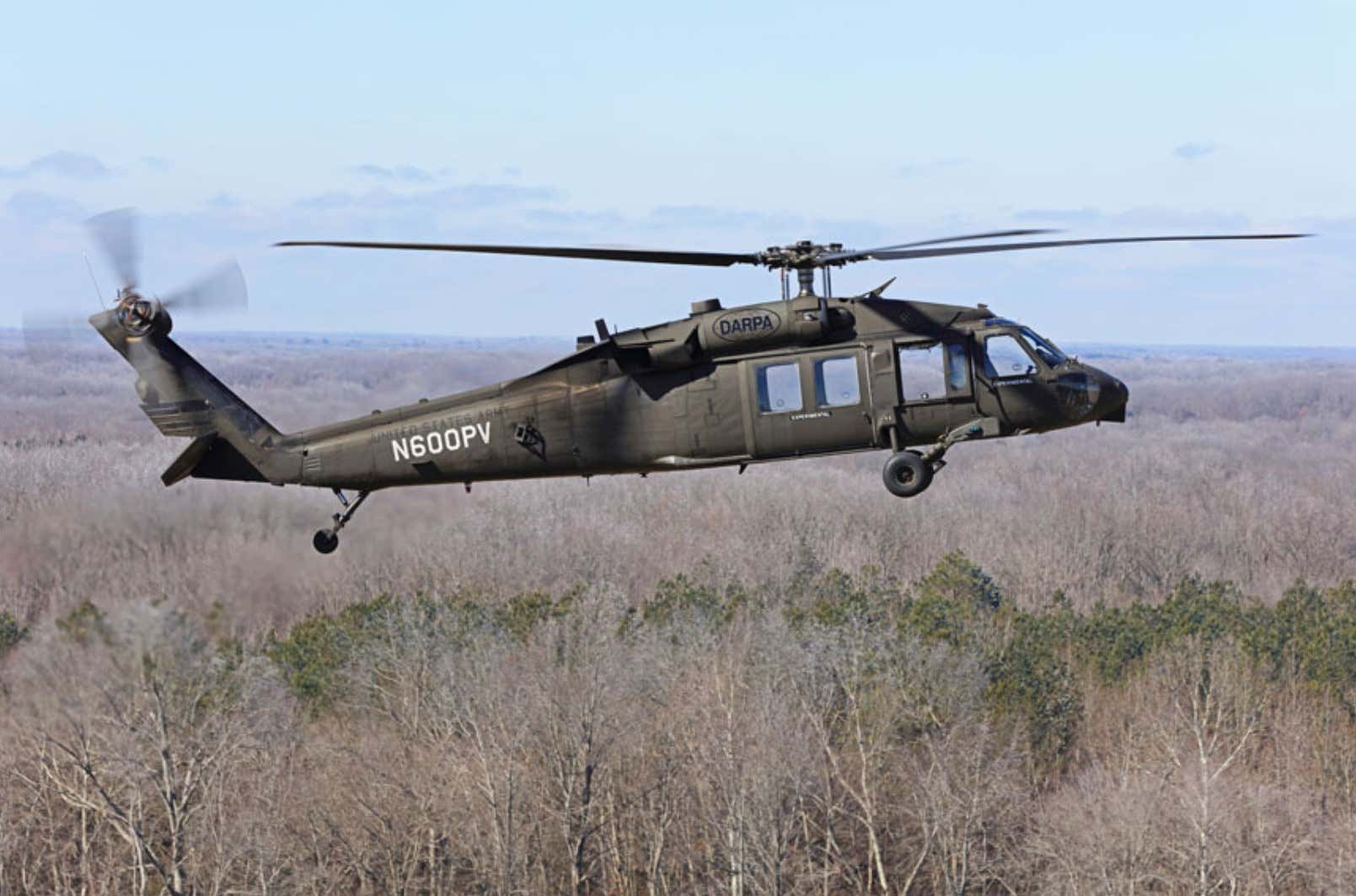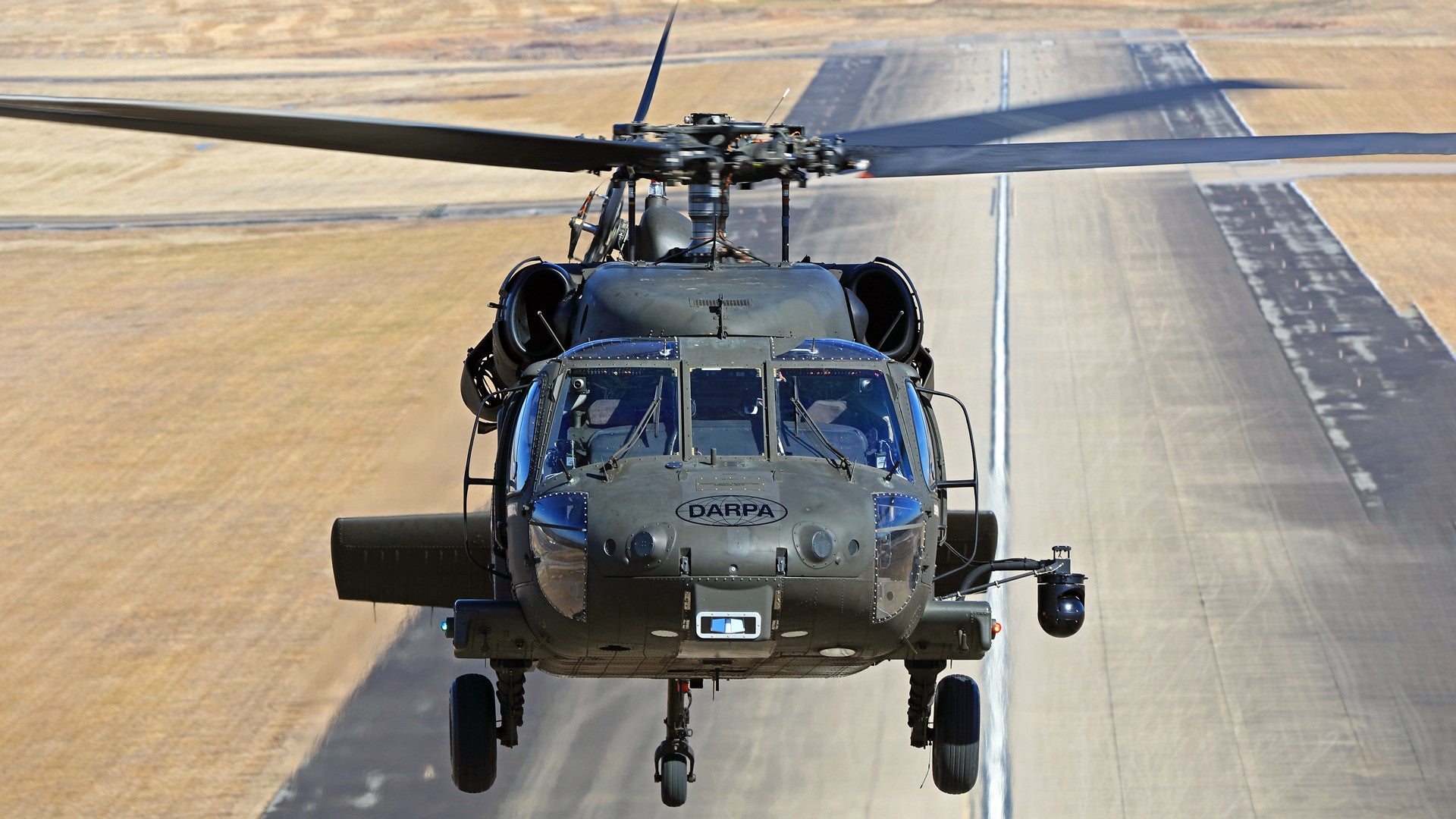A UH-60 Black Hawk Helicopter Just Flew Without Anyone Onboard For The First Time
A modified pilot-optional
UH-60 Black Hawk helicopter has flown for the first time ever without a single human crew member onboard. The test flight utilized
a suite of systems that are designed primarily to help improve the helicopter pilots' performance and offer additional margins of safety, but that could also provide a stepping stone to even greater autonomous capabilities down the road.
The Defense Advanced Research Projects Agency, or DARPA, in cooperation with Lockheed Martin subsidiary Sikorsky,
conducted the test flight involving the specially configured UH-60A testbed, which lasted roughly 30 minutes, at the Army's Fort Campbell in Kentucky on February 5. Another unmanned flight involving the same helicopter, which Sikorsky owns and has the U.S. civil registration code N600PV, took place on February 7. There are no additional details available so far about this second test. DARPA says it now plans to conduct the first flight of a fly-by-wire UH-60M equipped with this same system at Fort Eustis, Virginia sometime within the next month.
"To demonstrate its ability to adapt to a variety of mission environments, the uninhabited Black Hawk navigates at typical speed and altitude through a simulated cityscape, avoiding imagined buildings while route re-planning in real time." a Lockheed Martin press release says in describing the exact nature of the first entirely uncrewed flight test. "All the while, on-board sensor simulation provides real-time obstacle data."
"The Black Hawk helicopter then autonomously executes a series of pedal turns, maneuvers and straightaways before completing a perfect landing," it continues. "Once it shuts itself down, the two pilots approach and re-enter the aircraft. The OPV (optionally-piloted vehicle) switch is reversed from zero to two, and then the pilots taxi back down the runway."
DARPA
The pilot-optional UH-60A, seen in flight without any pilots or other crew members aboard.
These recent test flights are the latest developments in DARPA's
Aircrew Labor In-Cockpit Automation System (ALIAS) program, which began in 2014. ALIAS leverages Sikorsky’s
Matrix technology, a combination of software and hardware components that interfaces with an aircraft’s existing electronics and mechanical control systems, which has been in development since 2013. ALIAS has also been tested on
a Sikorsky S-76B helicopter and a fixed-wing
Cessna 208 Caravan in the past.
The expectation remains that aircraft equipped with ALIAS will still generally have pilots and other aircrew on board to oversee a flight. The ALIAS system is described as a “tailorable, drop-in, removable kit.” It is designed to be capable of supporting an entire mission from takeoff to landing and can assume control of an aircraft in the event of emergencies or any other situation that requires aviators to take the attention away from controlling the aircraft. Crew members can use a handheld tablet to control the system and change flight paths or other parameters mid-flight. They can also take over and resume direct control of the aircraft when needed.
Lockheed Martin
Test pilots control an ALIAS-equipped UH-60A Black Hawk with a tablet interface.
“This capability will allow pilots to confidently switch back and forth between autonomy and piloted modes at any point of their mission with the literal flip of a switch," Benjamin Williamson, the lead test pilot for the Fort Campbell flights, said
in a statement from Lockheed Martin. "This will support autonomous flight during a wide range of missions such as flight in
degraded visual environments (DVE) and confined areas. Most critically, ALIAS will be capable of automatically detecting and preventing dangerous situations that lead to accidents, thereby saving lives.”
Helicopters can be especially challenging to fly in DVE conditions where bad weather or smoke, dust, or other obscurants significantly limit visibility. Attempting to maneuver a helicopter into a confined landing zone presents its own complexities. All of this increases physical and mental workloads for pilots, which can increase the potential for serious mistakes, especially when combined with the stresses of combat or general fatigue. Having what has been described variously as a "
digital co-pilot" or "supervised autonomy" could help helicopter pilots and other crew members manage things in these circumstances, as well as just keep an eye out for issues in general.
“With reduced workloads pilots can focus on mission management instead of the mechanics,” Stuart Young, the ALIAS program manager in DARPA’s Tactical Technology Office, said
in a separate statement today. “This unique combination of autonomy software and hardware will make flying both smarter and safer.”
At the same time, the advanced autonomous capabilities that ALIAS offers, which could be further expanded on as
artificial intelligence and machine learning technology continue to improve, open doors to new concepts of operations that don't necessarily involve pilots or other aircrew, at all.
“With ALIAS, the Army will have much more operational flexibility,” DARPA's Young explained. “This includes the ability to operate aircraft at all times of the day or night, with and without pilots, and in a variety of difficult conditions, such as contested, congested, and degraded visual environments.”
DARPA's press release further notes that the Army, which
has been heavily involved in the ALIAS program for years now, "is currently exploring potential use cases for technologies such as ALIAS, including those outlined in the U.S. Army’s Future Vertical Lift (FVL) program." FVL is a multi-faceted effort that the Army is leading that is focused on developing and acquiring
a number of
new helicopters or
other rotorcraft designs to replace the bulk of its existing rotary-wing fleets. Other services might
then acquire variants or derivatives of those aircraft to
supplant their own existing types.
"Sikorsky’s advancements in flight automation and autonomy will be game-changers for Army aviators and ground commanders, particularly as the Army looks to modernize its enduring helicopter fleet with Future Vertical Lift," he said. “This transformational technology will provide commanders and aircrews with a strategic advantage in countering complex new threat environments.”
Various components of the broader FVL effort, such as the
Future Attack Reconnaissance Aircraft (FARA) program, have previously specified requirements for autonomous operation and pilot-optional flight. Last year, the ALIAS-equipped UH-60A participated in the
Army's Project Convergence 2021 exercise, the second in an ongoing series of large-scale test events to evaluate a
variety of new and
advanced weapons and
other systems, as well as concepts of operation for how to employ them.
When it comes to potential missions an ALIAS-equipped helicopter, the Army and the Marine Corps, in particular, have
expressed interest in
autonomous resupply aircraft in recent years, a task that could potentially be offloaded onto autonomous systems in some situations. As ALIAS and other semi-autonomous, optionally-manned flight systems continue to mature, we may eventually see these systems reach the point where they can replace at least some crew members in some circumstances, allowing pilots and other personnel to be allocated towards more operationally demanding needs.
Whether or not ALIAS ever replaces human crews entirely, the ability to help aviators make better decisions or multitask in a variety of
demanding conditions could ultimately save lives. As DARPA continues its work with the system, we can expect to see further ALIAS demonstrations that could expand to other, more varied platforms and offer greater flexibility in the cockpit.
The technology used in the flight could take over for aviators in the event of emergencies, help reduce their general workload, and much more.

www.thedrive.com








